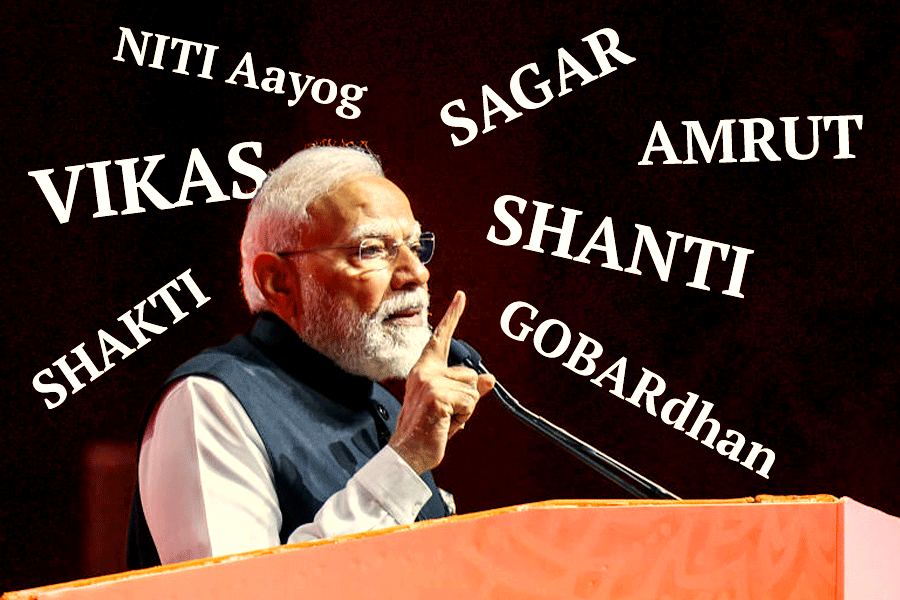 |
| Associate professor Banibrata Mukhopadhyay (right) and PhD student Upasana Das at IISc, Bangalore |
New Delhi, Feb. 18: Two Indian astrophysicists have revised a sacrosanct obesity limit for aged stars imposed eight decades ago by the India-born American Nobel laureate in physics Subrahmanyan Chandrasekhar.
Pencil-and-paper calculations by associate professor Banibrata Mukhopadhyay and his student Upasana Das at the Indian Institute of Science, Bangalore, may also help explain some puzzling observations of exploding stars that have baffled astronomers over the past decade.
In the 1930s, Chandrasekhar had challenged the prevailing idea that all stars, after exhausting their hydrogen fuel, shrink and turn into 'white dwarfs.' He had predicted through calculations that stars with masses greater than 1.44 times the mass of the Sun are destined to collapse, implying the existence of dense objects called neutron stars and black holes. His work also implied that white dwarfs that are able to draw matter from a neighbouring star and exceed the 1.44 mass limit explode violently as supernovae. This Chandrasekhar limit of 1.44, although questioned at times, has largely been regarded as an inviolable number in astrophysics that determines [ ] stars’ fates.
But Mukhopadhyay and Das have now shown that some white dwarfs [ ] stars in the final stages of their life- cycles — may safely acquire masses of up to 2.58 times the Sun’s mass before they too obliterate themselves as supernovae.
Their findings, just published in the journal Physical Review Letters, suggest that white dwarfs with extremely high magnetic fields may continue to acquire masses beyond 1 .44 times the Sun’s mass.
Astronomers believe these results may offer a possible explanation for the discovery since 2003 of several “overluminous supernovae” — so bright that their parent stars appeared to have had masses between 2.1 and 2.5 times the Sun’s mass — and had thus violated the Chandrasekhar mass limit.
“This looks like a great mathematical idea, driven by the need to explain these peculiar supernovae,” said Arikkala Raghuram Rao, an astronomer at the Tata Institute of Fundamental Research, Mumbai. Rao was not associated with the IISc calculations, but is hoping to launch a collaborative search for white dwarfs with extremely high magnetic fields.
The IISc researchers added the effects of an extremely high magnetic field in the chain of mathematical equations that are used to predict the fates of white dwarf stars, and found that such “magnetised white dwarfs” can add more weight than dictated by the Chandrasekhar limit.
“But when they grow to 2.58 times the mass of the Sun, even the extremely high magnetic fields cannot prevent the white dwarfs from exploding into supernovae,” Mukhopadhyay said.
“Chandrasekhar was correct when he calculated the 1.44 limit, but his calculations were confined to white dwarfs devoid of magnetic fields — when we add the effects of strong magnetic fields, the limit shifts to 2.58,” Mukhopadhyay told this newspaper.
Scientists familiar with this research area say the calculations by the IISc team are fairly straightforward. “They don’t rely on any technical or computational breakthroughs — so I’m surprised that no one else looked at this before,” said Armen Sedrakian, an astrophysicist at the Goethe University in Frankfurt, Germany, studying white dwarfs.
Astrophysicists also caution that such theoretical work would need to be validated through real observations of white dwarfs with extremely high magnetic fields.
“People have been trying to fine-tune the 1.4 Chandrasekhar limit for decades, trying to tweak it depending on the composition and properties of the white dwarfs, but this is a dramatic shift nearly twice higher,” said Sandip Chakrabarti, a senior professor at the S.N. Bose National Centre for Basic Sciences, Calcutta.
“Thousands of white dwarfs have been catalogued — but none of them seem to have masses above the Chandrasekhar limit,” said Chakrabarti who had spent three years working with Chandrasekhar at the University of Chicago during the early 1980s. “If white dwarfs can grow beyond this up to 2.58, the question is — where are they?”
While some proportion of white dwarfs have been observed with relatively weak magnetic fields, there is none catalogued yet with the extremely high magnetic field that appears necessary to breach the Chandrasekhar limit. “We need to establish whether nature has such exotic objects,” Rao said.
A new higher mass limit for some supernovae may also compel cosmologists to reconsider existing ideas about the expansion of the universe.
The 1.44 mass limit has allowed astronomers to use distant supernovae as “standard cosmological candles” to measure the distance to their host galaxies.
Such measurements of distant supernovae over the past 15 years have led cosmologists to suggest that the expansion of the universe is accelerating under the influence of an unexplained “dark energy”.
But the higher mass limit proposed by Mukhopadhyay and Das could mean a second standard candle for distance measurements. This could have “far-reaching implications”, the IISc scientists wrote in their research paper, “including a possible reconsideration of the expansion history of the universe.”










